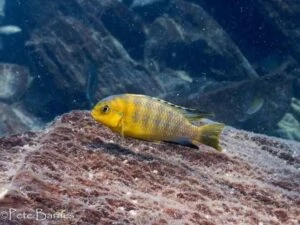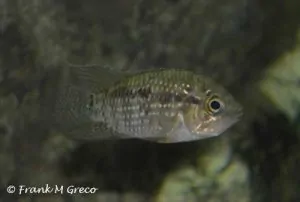Apistogramma cacatuoides – Cockatoo Cichlid
Apistogramma cacatuoides was described in 1951 by Hoedeman. The species name cacatuoides is named after the cockatoo. The male’s front dorsal fin rays are elongated and can be erect like a Cockatoo’s crest.
The genus name Apistgramma can be divided into two ancient Greek words. Apisto means uncertain and gramma means signal. A reference to the variably developed lateral line. This largely consists only of scales with pores.
The genus Apistogramma has many species. There are currently about 90 officially described species, but a large number of species are still awaiting their description.
Description
The Apistogramma cacatuoides or Cockatoo Cichlid is likely the most sturdy of the Apistogramma genus. This is the reason these fish are suited for beginners who can even breed with these fish. The cockatoo cichlid can be kept in water with a neutral pH varying from 6.8 to 7.6. They are likely to cope better with temperature changes and this makes them easier for beginners to keep.
Males of the Apistogramma cacatuoides are slightly bigger than the females and the coloring is also more vivid with the males than with females. The dorsal and caudal fins have attractive orange coloring. Females have a brown/greyish tone that changes when they want to mate. Colors in females will then change to yellow and black.
The maximum total length of the male is around nine centimeters. The females remain somewhat smaller at six centimeters. Because of their small size, they are counted among the Dwarf Cichlids.
Breeding variants
Several breeding forms are now available, such as the Double Red or Tripple Red. These names refer to the presence of red in the fins. Apistogramma cacatuoides Double Red variants have red in the dorsal and caudal fins. The Apistogramma cacatuoides Tripple Red variants have red in the dorsal, caudal, and anal fins.
The Apistogramma cacatuoides Sunburst breeding variety also has red in the fins, but the black spots in the red are missing.

Origin
The Apistogramma cacatuoides can be found in Peru, Colombia, and Brazil in South America. They inhabit the slower-flowing rivers, streams, and creeks. Preferably, they choose a place where some leaves have been collected on the bottom. The water can be black water, white water, or clear.
The Aquarium
You can keep the Apistogramma cacatuoides in an aquarium of at least 80 centimeters in length, but preferably from 100 centimeters. The aquarium should be well-planted at the back and sides. There should also be plenty of hiding places in the form of an upturned flower pot, a coconut, or rocks. This fish is a cave brooder.
Diet
The Cockatoo Cichlid’s diet can consist of an alternation of dry food and frozen/live food such as brine shrimp, mysis, cyclops, daphnia (water fleas), black mosquito larvae, and white mosquito larvae. They prefer sand as a substrate, which they bite into and filter out detritus, which is their natural food.
Character
Apistogramma cacatuoides can be spicy fish, especially when they have eggs or fry. Take this into account when setting up the tank and choosing fellow residents. Combining with other soil-oriented species can go wrong.
Apistogrammas are often kept in a harem, with cacatuoides it is wise to keep 1 male with 3 females in a tank from one meter. In larger tanks (from 1.50m) you can also keep them in a group, this gives more natural behavior. Keep in mind to have at least 3 males and 2 or more females per male. If you choose to keep 1 male with 1 female, it may happen that he chases too much after the one female to mate. Usually, the female does not survive this.
Breeding Apistogramma cacatuoides – Cockatoo Cichlid
The eggs of the Apistogramma cacatuoides are preferably deposited in a cave. These don’t have to be big, as long as the female just fits in them. Half a coconut or a stone flower pot upside down is enough. The eggs are deposited on the ceiling of the cave and hatch after 3 to 4 days. The female will guide the fry through the tank for the next week while the male keeps the other fish away. If you want to keep young fish, it is better to separate the breeding pair as soon as the young have hatched or remove the male. In the absence of other fish to chase away, he will target the female and fry.
Video
Author
John de Lange – Bert van Rooij – Jelle Touwen
Copyright images
Angelique
J. de Lange
F. Ingemann Hansen – Akvariefotografen.com
Evelien van der Weide































Reviews
There are no reviews yet.